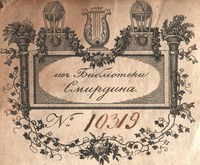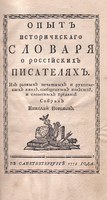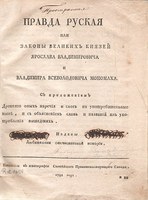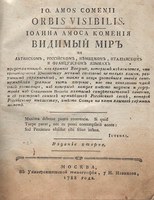The Library of A. F. Smirdin – Further Information
 Periodicals
Periodicals
Although it is only a part of Smirdin’s original library, the collection deposited in the Slavonic Library in Prague contains numerous important and very valuable printed items essential for the history of Russian literature. An entire range of leading literary journals have been preserved, albeit often only fragmentarily. Among periodicals of the second half of the 18th century, it is necessary to mention the satirical literary weekly Truten’, which was published by Nikolai I. Novikov and became famous for its fierce polemics against the official satirical journal Vsiakaia vsiachina, which is also part of the collection. Other periodicals from the same period include the first private literary journal in Russia, the monthly Trudoliubivaia pchela, which was issued by Aleksandr P. Sumarokov; the literary monthly Sobesednik liubitelei rossiiskogo slova, in whose editing Tsarina Catherine II and the Director of the Imperial Academy of Sciences, Duchess Ekaterina R. Dashkova, were involved; and, for instance, the literary weekly Utrennie chasy, to which Gavrila R. Derzhavin, Ivan I. Dmitriev and others contributed.
Periodicals from the turn of the 19th century include incompletely preserved volumes of the oldest Russian newspaper (the daily Sanktpeterburgskie vedomosti), which was issued by the Academy of Sciences, and the newspaper of Moscow University Moskovskie vedomosti.
The first half of the 19th century is represented mainly by the biweekly Moskovskii telegraf, which occupied a prominent position in the social and literary life of its time and was published by Nikolai A. Polevoi; Severnaia pchela, the first major private newspaper of political and literary nature, headed by Faddei V. Bulgarin and Nikolai I. Grech; the magazines Moskovskii vestnik and Moskvitianin, both connected with the names of Mikhail P. Pogodin and Stepan P. Shevyrev.
Early Printed Books
Printed items from the 18th century comprise works of the genius of Russian culture Mikhail V. Lomonosov, the earliest of which is Kratkoe rukovodstvo k krasnorechiiu from 1748. The work Razgovor mezhdu chuzhestrannym chelovekom i rossiiskim ob orfografii starinnoi i novoi by the leading Russian classicist Vasilii K. Trediakovskii comes from the same year. This group further includes works of a major playwright and the first Russian professional writer Aleksandr P. Sumarokov or the Russian men-of-letters of the transition period between classicism and sentimentalism Ivan I. Khemnitser, Mikhail M. Kheraskov and Vasilii V. Kapnist. The first printed collection of Russian proverbs Sobranie 4291 drevnikh rossiiskikh poslovits was prepared by Anton A. Barsov and published in 1770. Nikolai I. Novikov is the author of the first Russian biographical dictionary Opyt istoricheskogo slovaria o rossiiskikh pisateliakh from 1772, containing more than 300 entries devoted to Russian writers and scientists.
Literary Works
Works by writers of the first half of the 19th century in the collection include Pushkin’s collected works, Gogol’s short-story collection Mirgorod (1835, 1842), Krylov’s fables, Lermontov’s poems and novel Geroi nashego vremeni (A Hero of Our Time, 1843), Griboedov’s comedy in verse Gore ot uma (Woe from Wit, 1833), as well as editions of Baratynskii, Batiushkov, Derzhavin, Gnedich, Karamzin, Kniazhnin, Koltsov, Kozlov, Lazhechnikov, Narezhnii, Podolinskii, Pogorelskii, Polevoi, Ryleev, Veltman, Venevitinov, Viazemskii, Zagoskin, Zhukovskii etc. from that time.
Regarding translations of world literature, the most frequent authors are Walter Scott; August von Kotzebue, a German playwright who was the most played in his time; and a French writer, now long-forgotten author of historical novels, Stéphanie de Genlis. Besides various translations of authors known only to literary historians, the collection contains numerous writers since antiquity whose works have become part of world cultural heritage, e.g. Homer, Sophocles, Ovid, Virgil, Horace, Tasso, Shakespeare, Molière, Racine, Cervantes, Lesage, Voltaire, Rousseau, E. T. A. Hoffmann, Theodor Körner, Wieland, Goethe, Lessing, de Vigny, Balzac, George Sand, Fenelon, Dumas, Byron, Young, Richardson, Dickens etc.
Theology and Philosophy
In the section of theological literature, it is particularly worth mentioning works of the Church Fathers, both of Western (Augustine of Hippo) and Eastern Christianity (John Chrysostom, St Basil the Great). The collection contains also a Russian translation of the treatise Cyrill und Method der Slawen Apostel by Josef Dobrovský, which was published by Mikhail P. Pogodin in 1825 (Kirill i Mefodii, slovenskie pervouchiteli).
In the section of philosophical literature, one can find i.a. works of Voltaire, Rousseau and La Rochefoucauld; the founding figure of J. H. Pestalozzi stands out among pedagogues.
Historical, Legal and Geographical literature
The section of history includes Russian translations of works of ancient historians Herodotus, Tacitus, Plutarch and Marcus Aurelius. Among historians focusing on the history of Russia, one can mention Nikolai M. Karamzin, Mikhail M. Shcherbatov, Nikolai G. Ustrialov and the German historian Johann G. Stritter; literary works include Povest’ vremennykh let, also known as Nestor’s Chronicle (Letopisʼ Nestorova, po drevneishemu spisku Mnikha Lavrentiia, 1824). There is a rich selection of literature related to the personality of Napoleon Bonaparte and his time.
Legal literature comprises the first edition of the Russian Truth, the earliest legal code of the Eastern Slavs, which is an important historical source for the study of Kievan Rus’, in a detailed wording (Pravda Russkaia, ili, Zakony Velikikh Kniazei Iaroslava Vladimirovicha i Vladimira Vsevolodovicha Monomakha…, 1792). Unique works of geographical literature are e.g. Atlas rossiiskii, sostoiashchii iz deviatnadtsati spetsiaľnykh kart, predstavliaiushchikh Vserossiiskuiu Imperiiu s pogranichnymi zemliami, published in 1745 by the Academy of Sciences in St Petersburg and Istoricheskoe, geograficheskoe i topograficheskoe opisanie Sanktpeterburga by Andrei I. Bogdanov from 1779, with copperplate engravings.
Bohemica
Smirdin’s library contains also several books directly or indirectly connected with the area of the present Czech Republic and Czech political and cultural history.
A work related to Czech studies is Macpherson’s Ossian, syn Fingalov (1792), the original of which i.a. became the model for Rukopis královédvorský [Manuscript of Dvůr Králové]. Although its Russian translation (Rukopis’ Kralodvorskaia, 1820) has not been preserved in Smirdin’s collection, it can be found in another collection of the Slavonic Library. A German author born in Prague, Georg E. Opiz, is represented by a novel set in Bohemia during the Thirty Years’ War and published under the pseudonym Bohemus (Izgnannik: Istoricheskii roman iz smutnykh vremen Bogemii, v prodolzhenie tridtsati-letnei voiny, 1834). The library contains several volumes of selected works by the once popular author of Gothic novels Christian H. Spiess, who died in Bohemia in 1799. The collection includes even the world-famous autobiography by Silvio Pellico (Zapiski Silvio Pelikko Sallutskago, 1836), in which he described his experiences from his imprisonment at Špilberk Castle in Brno.
In the linguistic section, special attention should be paid to the Russian edition of J. A. Comenius’ Orbis pictus from 1788, called Vidimyi mir, and to Pogodin and Shevyrev’s translation of Dobrovský’s Institutiones linguae slavicae dialecti veteris, published in 1833‒1834 (Grammatika iazyka slavianskago po drevnemu narechiiu).
Curiosities
Smirdin’s library comprises a whole range of printed books, whose titles may provoke a smile among modern readers. They include mainly practical handbooks and various considerations. Here are English translations of at least some of the titles:
- A New Method of Killing Cockroaches, Flies and Fleas with a Short Instruction on How to Protect Furs from Moths and Remove Stains (Moscow 1828);
- A Mole Hunter or the Easiest and Surest Method of Mole Hunting (Moscow 1826, translated from French);
- The Latest Killer of Moths, Flies, Bed Bugs, Spiders, Fleas, Lice, Mosquitoes, Ants, Bread Worms, Moles, Caterpillars, Cockroaches, Crickets, Mole Crickets, Grubs: Complemented with the Newly Invented Method of Growing and Ripening Pineapples, Asparagus, Pumpkins, Cucumbers, Strawberries, Radishes and Other Plants, Likewise Roses and Many Other Flowers Indoors in Winter without Hotbeds and the Help of Professional Growers (Moscow 1837);
- A Very Beneficial Use of Paper for House Roofing (St Petersburg 1806);
- A Beauty Advisor, Showing Reliable Methods and Means of Preserving and Acquiring the Beauty of the Face, Teeth, Hands, in Short the Entire Body, of Banishing Bad Breath, Growing Beautiful Hair etc. (Moscow 1791, translated from German);
- A Treatise on the Manifestations of Human Impulsiveness Resulting from Long-Term Excessive Alcohol Consumption (Moscow 1827, translated from French);
- On the Effects of Nature on the Multiplication of the Human Race or On the Desire of One Sex for the Other, on Fertility, Conception, Birth and the Protection of Infants, on Delivering Healthy Babies and on Preserving One’s Strength and Health with a Demonstration of Harmless and Time-Tested Means to Strengthen Weak Organs (Moscow 1848, translated from German).

















